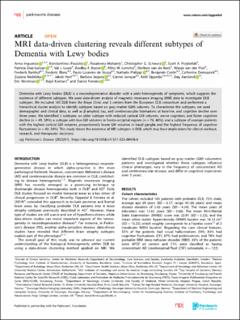| dc.contributor.author | Inguanzo, Anna | |
| dc.contributor.author | Poulakis, Konstantinos | |
| dc.contributor.author | Mohanty, Rosaleena | |
| dc.contributor.author | Schwarz, Christopher G. | |
| dc.contributor.author | Przybelski, Scott A. | |
| dc.contributor.author | Diaz-Galvan, Patricia | |
| dc.contributor.author | Lowe, Val J. | |
| dc.contributor.author | Boeve, Bradley F. | |
| dc.contributor.author | Lemstra, Afina W. | |
| dc.contributor.author | van de Beek, Marleen | |
| dc.contributor.author | van der Flier, Wiesje | |
| dc.contributor.author | Barkhof, Frederik | |
| dc.contributor.author | Blanc, Frederic | |
| dc.contributor.author | Loureiro de Sousa, Paulo | |
| dc.contributor.author | Philippi, Nathalie | |
| dc.contributor.author | Cretin, Benjamin | |
| dc.contributor.author | Demuynck, Catherine | |
| dc.contributor.author | Nedelska, Zuzana | |
| dc.contributor.author | Hort, Jakub | |
| dc.contributor.author | Segura, Barbara | |
| dc.contributor.author | Junque, Carme | |
| dc.contributor.author | Oppedal, Ketil | |
| dc.contributor.author | Aarsland, Dag | |
| dc.contributor.author | Westman, Eric | |
| dc.contributor.author | Kantarci, Kejal | |
| dc.contributor.author | Ferreira, Daniel | |
| dc.date.accessioned | 2023-12-04T11:14:34Z | |
| dc.date.available | 2023-12-04T11:14:34Z | |
| dc.date.created | 2023-04-26T08:49:16Z | |
| dc.date.issued | 2023 | |
| dc.identifier.citation | Inguanzo, A., Poulakis, K., Mohanty, R., Schwarz, C. G., Przybelski, S. A., Diaz-Galvan, P., ... & Ferreira, D. (2023). MRI data-driven clustering reveals different subtypes of Dementia with Lewy bodies. npj Parkinson's Disease, 9(1), 5. | en_US |
| dc.identifier.issn | 2373-8057 | |
| dc.identifier.uri | https://hdl.handle.net/11250/3105793 | |
| dc.description.abstract | Dementia with Lewy bodies (DLB) is a neurodegenerative disorder with a wide heterogeneity of symptoms, which suggests the existence of different subtypes. We used data-driven analysis of magnetic resonance imaging (MRI) data to investigate DLB subtypes. We included 165 DLB from the Mayo Clinic and 3 centers from the European DLB consortium and performed a hierarchical cluster analysis to identify subtypes based on gray matter (GM) volumes. To characterize the subtypes, we used demographic and clinical data, as well as β-amyloid, tau, and cerebrovascular biomarkers at baseline, and cognitive decline over three years. We identified 3 subtypes: an older subtype with reduced cortical GM volumes, worse cognition, and faster cognitive decline (n = 49, 30%); a subtype with low GM volumes in fronto-occipital regions (n = 76, 46%); and a subtype of younger patients with the highest cortical GM volumes, proportionally lower GM volumes in basal ganglia and the highest frequency of cognitive fluctuations (n = 40, 24%). This study shows the existence of MRI subtypes in DLB, which may have implications for clinical workout, research, and therapeutic decisions. | en_US |
| dc.language.iso | eng | en_US |
| dc.publisher | Springer Nature | en_US |
| dc.rights | Navngivelse 4.0 Internasjonal | * |
| dc.rights.uri | http://creativecommons.org/licenses/by/4.0/deed.no | * |
| dc.title | MRI data-driven clustering reveals different subtypes of Dementia with Lewy bodies | en_US |
| dc.type | Peer reviewed | en_US |
| dc.type | Journal article | en_US |
| dc.description.version | publishedVersion | en_US |
| dc.rights.holder | © The Author(s) 2023 | en_US |
| dc.subject.nsi | VDP::Medisinske Fag: 700 | en_US |
| dc.source.volume | 9 | en_US |
| dc.source.journal | NPJ Parkinson's Disease | en_US |
| dc.source.issue | 1 | en_US |
| dc.identifier.doi | 10.1038/s41531-023-00448-6 | |
| dc.identifier.cristin | 2143392 | |
| cristin.ispublished | true | |
| cristin.fulltext | original | |
| cristin.qualitycode | 1 | |

